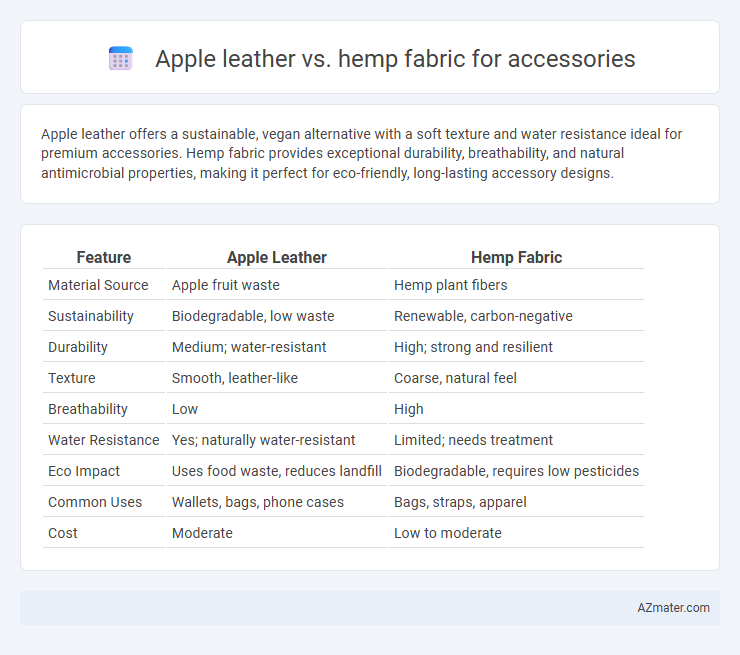Apple leather offers a sustainable, vegan alternative with a soft texture and water resistance ideal for premium accessories. Hemp fabric provides exceptional durability, breathability, and natural antimicrobial properties, making it perfect for eco-friendly, long-lasting accessory designs.
Table of Comparison
| Feature | Apple Leather | Hemp Fabric |
|---|---|---|
| Material Source | Apple fruit waste | Hemp plant fibers |
| Sustainability | Biodegradable, low waste | Renewable, carbon-negative |
| Durability | Medium; water-resistant | High; strong and resilient |
| Texture | Smooth, leather-like | Coarse, natural feel |
| Breathability | Low | High |
| Water Resistance | Yes; naturally water-resistant | Limited; needs treatment |
| Eco Impact | Uses food waste, reduces landfill | Biodegradable, requires low pesticides |
| Common Uses | Wallets, bags, phone cases | Bags, straps, apparel |
| Cost | Moderate | Low to moderate |
Introduction to Sustainable Materials in Fashion
Apple leather, derived from apple waste, offers a biodegradable and cruelty-free alternative to traditional leather, reducing environmental impact in fashion accessories. Hemp fabric, known for its durability and low water consumption, provides a renewable and breathable material that supports sustainable production practices. Both materials exemplify innovative approaches to eco-friendly design, emphasizing resource efficiency and waste reduction in the accessory industry.
What is Apple Leather?
Apple leather is an innovative, sustainable material made from apple waste, specifically the pulp and peels left over from apple juice production, offering an eco-friendly alternative to traditional leather. This plant-based leather is durable, biodegradable, and cruelty-free, making it popular for accessories like bags, wallets, and shoes. Compared to hemp fabric, which is a natural textile derived from the fibers of the hemp plant known for its breathability and strength, apple leather provides a smooth, leather-like finish with added environmental benefits from upcycled fruit waste.
What is Hemp Fabric?
Hemp fabric is a durable and eco-friendly textile made from the fibers of the hemp plant, known for its strength and breathability, making it ideal for accessories. Unlike apple leather, which is a vegan leather alternative crafted from apple waste, hemp fabric offers a natural, biodegradable option with excellent moisture-wicking properties. Its sustainable cultivation requires fewer pesticides and less water, positioning hemp fabric as an environmentally responsible choice in accessory production.
Environmental Impact: Apple Leather vs Hemp
Apple leather uses apple peel waste, reducing landfill contributions and water consumption compared to traditional leather, but involves synthetic additives that may impact biodegradability. Hemp fabric is highly sustainable, requiring minimal water, pesticides, and fertilizers, and is fully biodegradable, offering a lower overall environmental footprint. Choosing hemp fabric over apple leather prioritizes natural resource conservation and end-of-life eco-friendliness in accessory production.
Durability and Longevity Comparison
Apple leather exhibits high durability due to its dense fiber structure and protective coating, making it resistant to scratches and wear over time. Hemp fabric is renowned for its exceptional strength and longevity, with natural resistance to stretching and UV damage, ensuring accessories maintain their integrity under frequent use. Comparing both, apple leather offers a smoother finish with moderate durability, while hemp fabric provides superior tensile strength and longer lifespan in diverse environmental conditions.
Comfort and Aesthetic Appeal
Apple leather offers a soft, smooth texture that enhances comfort for accessories like bags and wallets, providing a luxurious feel similar to traditional leather. Hemp fabric is breathable and lightweight, promoting comfort in warmer conditions, while its natural, woven texture delivers a rustic, eco-friendly aesthetic. Both materials appeal to sustainable fashion consumers, balancing comfort with distinct visual styles suitable for modern accessory design.
Cost and Accessibility
Apple leather offers a mid-range price point, making it a more affordable alternative to traditional leather, while hemp fabric tends to be less expensive due to its natural and sustainable cultivation process. Apple leather is available mainly through specialized suppliers focused on eco-friendly materials, which may limit accessibility compared to hemp fabric, widely accessible through multiple textile vendors globally. Cost-efficiency and broader market availability make hemp fabric a practical choice for budget-conscious accessory production.
Versatility in Accessory Design
Apple leather offers exceptional versatility in accessory design due to its smooth texture, durability, and ability to be molded into various shapes, making it ideal for bags, wallets, and watch straps. Hemp fabric provides a natural, breathable alternative with a rugged, eco-friendly appeal, suited for casual and bohemian-inspired accessories like totes and hats. Both materials support sustainable fashion trends but cater to different aesthetic and functional preferences in accessory versatility.
Ethical Considerations
Apple leather offers an eco-friendly alternative to traditional leather, made from apple waste that reduces agricultural byproducts and minimizes animal cruelty. Hemp fabric stands out for its sustainability, requiring less water and pesticides than cotton, and its biodegradable nature reduces environmental impact. Choosing between the two depends on specific ethical priorities such as veganism, resource consumption, and biodegradability in accessory production.
Which is Better for Accessories?
Apple leather offers a sustainable, vegan alternative with a smooth texture and excellent durability, making it ideal for high-end accessories like wallets and bags. Hemp fabric provides exceptional breathability, natural anti-bacterial properties, and superior strength, suitable for casual accessories such as backpacks and hats. Choosing between them depends on the desired accessory style, with apple leather favored for luxury items and hemp fabric preferred for eco-friendly, rugged designs.

Infographic: Apple leather vs Hemp fabric for Accessory
 azmater.com
azmater.com